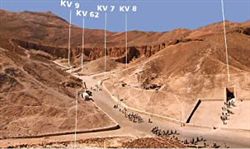
Royal necropolis of the New Kingdom, situated on the west bank of the Nile opposite Thebes. There are in fact two connected valleys, of which the eastern is the more important. The royal tombs from the 18th to 20th Dynasties are located here, as well as a few tombs of non-royal persons. The other valley, the western, contains four tombs. A total of 62 tombs have been given an official number, and there are at least three unnumbered tombs. Not all the numbered tombs belong to kings, some of them were constructed for members of the royal family, such as the one rediscovered in the mid 1990s, number 5, belonging to the sons of Ramesses II. There are also some tombs belonging to high officials, such as that of the vizier Amenemopet (Tomb 48). The oldest tomb is possibly that attributed to Tuthmosis I (Tomb 38), although some people think that the anonymous tomb 39 belonged to Amenhotep I. The most recent tomb is that of Ramesses XI. The tombs all consist of one or more chambers connected by corridors, carved out of the rock. The original idea was to seal the tomb after the dead king had been buried and hide the entrance under rubble. In this way it was hoped that tomb robbery would be avoided. The result was that the royal mortuary temples were no longer linked to the tomb, but were situated far away, on the edge of the desert. The architecture of the tombs shows a clear development. The oldest tombs, for example, have a corridor that turns at an angle of 90 ( and a burial chamber shaped like a cartouche. The funerary texts on the walls are usually from the Amduat. Later tombs consist of a sequence of chambers with one or more straight corridors linking them. The first tomb of this design was the royal tomb of Akhenaten at El-`Amarna. The oldest tombs in the Valley of the Kings built in this fashion are those of Ay and Horemheb. The Book of Gates appears for the first time on the walls of Horemheb's tomb. In later tombs, other funerary texts and representations may be found as well. Further, several tombs have an astronomical ceiling. The best known tomb from the Valley of the Kings is probably that of Tutankhamun, although it is very small. It was probably not intended for the king but for a high official (Ay?), but after the sudden death of Tutankhamun it was prepared for him. It is assumed that the tomb originally intended for Tutankhamun was Tomb 23, later used by Ay. In the 21st Dynasty, when tomb robbers were regularly plundering the tombs, some of the kings buried here were taken from their tombs by priests and reburied together in a cache near Deir el-Bahari and in the tomb of Amenhotep II. They were only rediscovered at the end of the nineteenth century.